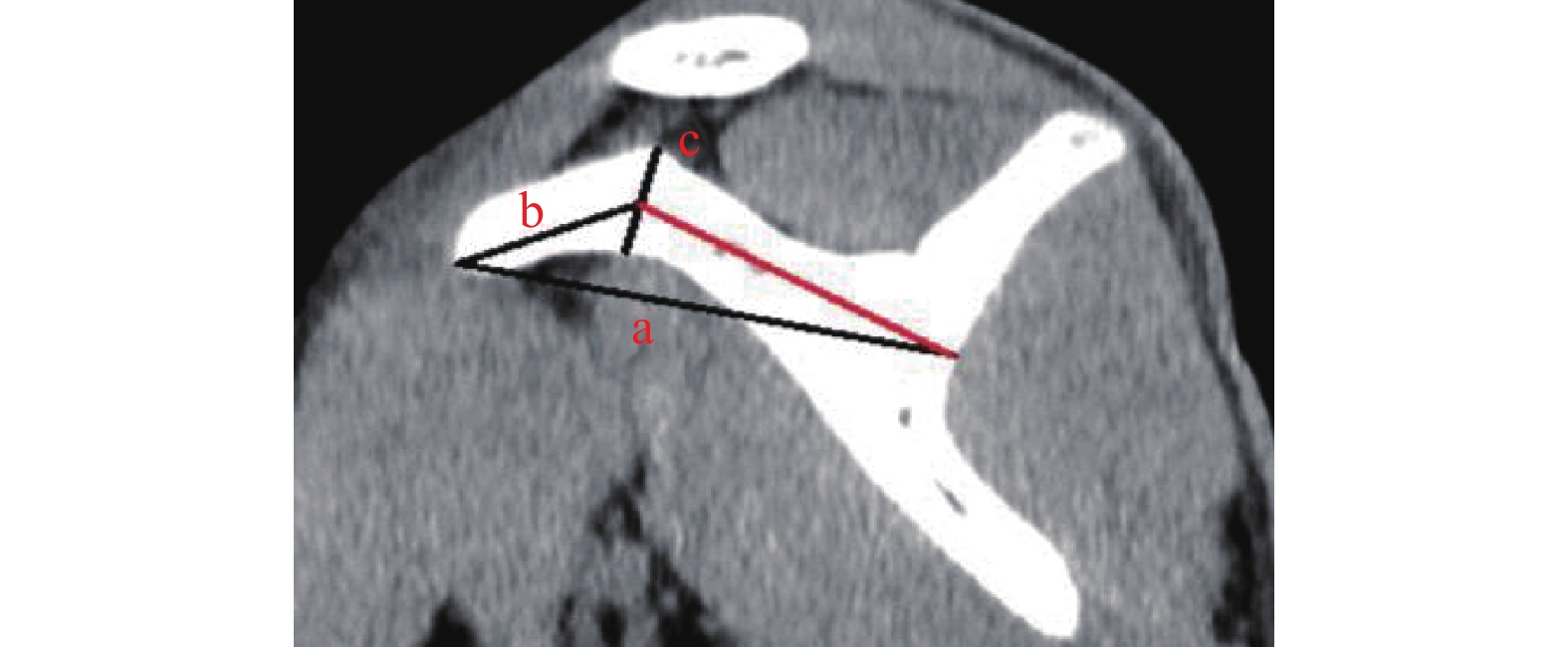A Retrospective Study of 64-row 128-slice Spiral CT Digital Imaging Data of Normal Adult Coracoid Process
-
摘要:
目的 探讨正常成人喙突的64排128层螺旋CT影像学特征,为临床喙突安全手术提供参考。 方法 随机抽取于2019年 01月至 2022年05月在云南省中医医院就诊的成年患者行肩关节64排128层螺旋CT扫描的影像 CT片121例资料作为样本,以肩关节矢状面为测量对象,测量喙突、喙突膝部的长度,测量喙突尖至喙突膝部中点的距离及喙突基底部、喙突尖的高度,再以肩关节矢状面为测量对象,测量喙突尖基底部、喙突膝部、喙突基底部的宽度;测量结果采用SPSS27.0统计学软件包进行统计学分析,基本描述正态分布计量资料采用平均值、中位数、标准差、最大值、最小值、 $\bar x \pm s $ 表示,正态分布计量资料2组间比较采用两独立样本t检验,相关性分析采用Pearson相关性分析。结果 喙突长度为(59.92±6.11)mm;喙突膝部长度为(14.05±2.26)mm;喙突尖至喙突膝部中点的距离为(22.59±3.65)mm;喙突尖基底部的高度为(9.86±1.71)mm;喙突尖高度为(7.22±1.79)mm;喙突尖的宽度为(9.14±2.08)mm;喙突膝部的宽度为(13.79±2.70)mm;喙突基底部的宽度为(21.10±4.18)mm;经两独立样本t检验,除了喙突尖的高度,男性与女性患者组间的喙突影像测量距离均有统计学意义(P < 0.05);左侧与右侧患者组间的喙突长度、喙突尖至喙突膝部中点的距离及喙突膝部的宽度均有统计学意义(P < 0.05);经Pearson相关性分析男性和女性喙突长度与喙突尖至喙突膝部中点的距离、喙突尖的宽度与喙突膝部的宽度均有相关性(P < 0.05)。 结论 喙突长度、宽度均与男女性别、左右侧有差异,其中无论是男性还是女性喙突长度与喙突尖至喙突膝部中点的距离、喙突尖的宽度与喙突膝部的宽度均有一定的关联;因此在临床喙突手术过程中或者相关器械耗材设计的时候应注意性别、左右侧以及它们之间的关联性。 -
关键词:
- 喙突 /
- 成年人 /
- 64排128层螺旋CT /
- 影像学 /
- 回顾性研究
Abstract:Objective To explore the imaging features of 64-row, 128-slice spiral CT of the normal adult coracoid process to provide a reference for clinical coracoid process safety surgery. Methods The data of 121 adult patients who underwent 64-row 128 slice spiral CT scanning of shoulder joints from January 2019 to May 2022 in Yunnan Provincial Hospital of traditional Chinese medicine were randomly selected as samples. The sagittal plane of the shoulder joint was taken as the measurement object to measure the length of the coracoid process and coracoid process knee, the distance from the coracoid process tip to the midpoint of coracoid process knee, and the height of the coracoid process base and coracoid process tip, and then the sagittal plane of the shoulder joint was taken as the measurement object to measure the base of coracoid process tip Width of coracoid process knee and coracoid process base; The measurement results were statistically analyzed by spss27.0 statistical software package. The basic description of normal distribution measurement data was expressed by mean, median, standard deviation, maximum value, minimum value and $\bar x \pm s $ . the normal distribution measurement data were compared by two independent sample t-test. Pearson correlation analysis was used for correlation analysis.Results The length of the coracoid process is 59.92±6.11 mm; the length of the coracoid knee is 14.05±2.26 mm; the distance from the coracoid tip to the midpoint of the coracoid knee is 22.59±3.65 mm; the height of the base of the coracoid tip is 9.86±1.71 mm; the height of the coracoid tip is 7.22±1.79 mm; the width of the coracoid tip is 9.14±2.08 mm; the width of the coracoid knee is 13.79±2.70 mm; the width of the coracoid base is 21.10±4.18 mm; Sample t-test, in addition to the height of the coracoid process tip, the coracoid image measurement distance between male and female patient groups was statistically significant (P < 0.05); the coracoid process length, coracoid process tip between left and right patient groups The distance to the midpoint of the coracoid knee and the width of the coracoid knee were statistically significant (P < 0.05); the length of the coracoid process in males and females and the length of the coracoid process to the midpoint of the coracoid knee were statistically significant (P < 0.05). The distance, the width of the coracoid tip and the width of the coracoid knee were all correlated (P < 0.05). Conclusion The length and width of the coracoid process are different from male and, gender and left and right, among which, the length of the coracoid process and the distance from the tip of the coracoid process to the midpoint of the knee of the coracoid process, the width of the tip of the coracoid process and the width of the knee of the coracoid process are different in both male and female. There are certain correlations; therefore, attention should be paid to gender, left and right, and the correlation between them during clinical coracoid surgery or the design of related equipment and consumables. -
Key words:
- Coracoid process /
- Adult /
- 64-slice 128-slice spiral CT /
- Imaging /
- Retrospective study
-
表 1 基本资料描述
Table 1. Description of basic data
指标 平均值 中位数 SD 最大值 最小值 a 59.92 59.08 6.11 75.76 42.99 b 14.05 14.07 2.26 18.87 8.55 c 22.59 22.52 3.65 31.33 14.74 d 9.86 9.85 1.71 14.36 5.84 e 7.22 7.17 1.79 11.39 3.48 f 9.14 8.66 2.08 17.38 4.56 g 13.79 13.69 2.70 21.29 6.98 h 21.10 21.21 4.18 11.49 30.00 总年龄 49.40 51.00 15.42 80.00 18.00 男性年龄 44.17 41.50 16.14 80.00 18.00 女性年龄 53.35 57.00 13.70 79.00 24.00 表 2 男性和女性情况比较(
$\bar x \pm s $ )Table 2. Comparison of male and female situations (
$\bar x \pm s $ )指标 男性 女性 t P a 63.59 ± 4.92 57.15 ± 5.44 6.714 < 0.001* b 15.52 ± 2.00 12.94 ± 1.77 7.488 < 0.001* c 25.01 ± 3.22 20.76 ± 2.80 7.763 < 0.001* d 10.46 ± 1.83 9.41 ± 1.48 3.502 0.001* e 7.54 ± 1.83 6.97 ± 1.73 1.740 0.085 f 9.69 ± 1.70 8.72 ± 2.26 2.599 0.011* g 14.69 ± 2.31 13.11 ± 2.79 3.319 0.001* h 23.13 ± 3.71 19.57 ± 3.86 5.108 < 0.001* *P < 0.05。 表 3 左侧和右侧情况比较(
$\bar x \pm s $ )Table 3. Comparison of left and right cases (
$\bar x \pm s$ )指标 左侧 右侧 t P a 61.22 ± 5.93 58.76 ± 6.07 2.241 0.027* b 14.39 ± 2.19 13.75 ± 2.29 1.574 0.118 c 23.47 ± 3.85 21.80 ± 3.30 2.562 0.012* d 10.15 ± 1.83 9.60 ± 1.58 1.768 0.080 e 7.49 ± 1.86 6.97 ± 1.69 1.607 0.111 f 9.40 ± 2.20 8.90 ± 1.97 1.320 0.189 g 14.50 ± 2.63 13.16 ± 2.63 2.782 0.006 h 20.68 ± 4.00 21.48 ± 4.33 −1.049 0.296 *P < 0.05。 表 4 a和c相关性分析
Table 4. Correlation analysis of a and c
指标 r P 男性 0.405 0.003* 女性 0.524 < 0.001* *P < 0.05。 表 5 f和g相关性分析
Table 5. Correlation analysis of f and g
指标 r P 男性 0.378 0.006 女性 0.745 < 0.001* *P < 0.05。 -
[1] Murugesan G A,Mohideen S,Kamal K U. An isolated displaced coracoid fracture treated with open reduction internal fixation with 4 mm cannulated cancellous screw[J]. J Orthop Case Rep,2022,12(1):38-40. [2] Li C H,Skalski M R,Matcuk G R Jr,et al. Coracoid process fractures:anatomy,injury patterns,multimodality imaging,and approach to management[J]. Emerg Radiol,2019,26(4):449-458. doi: 10.1007/s10140-019-01683-2 [3] Hsu K L,Yeh M L,Kuan F C,et all. Biomechanical comparison between various screw fixation angles for Latarjet procedure:a cadaveric biomechanical study [published online ahead of print,2022 Apr 6][J]. J Shoulder Elbow Surg,2022,22:S1058-1064. [4] Galvin J W,Kang J,Ma R,Li X. Fractures of the coracoid process:Evaluation,management,and outcomes[J]. J Am Acad Orthop Surg,2020,28(16):e706-e715. doi: 10.5435/JAAOS-D-19-00148 [5] 顾晓清,董芹,沈卫忠,等. 肩关节MRI喙-肱间距与喙突下撞击综合征的相关性[J]. 放射学实践,2021,36(4):520-523. doi: 10.13609/j.cnki.1000-0313.2021.04.019 [6] Chahla J,Marchetti D C,Moatshe G,et al. Quantitative assessment of the coracoacromial and the coracoclavicular ligaments with 3-dimensional mapping of the coracoid process anatomy:A cadaveric study of surgically relevant Structures[J]. Arthroscopy,2018,34(5):1403-1411. doi: 10.1016/j.arthro.2017.11.033 [7] 俞佳凤,孙岩,张静,等. 喙突下撞击综合征的磁共振成像测量研究[J]. 实用放射学杂志,2020,36(8):1281-1285. [8] Ogawa K,Matsumura N,Yoshida A. Nonunion of the coracoid process:a systematic review[J]. Arch Orthop Trauma Surg,2021,141(11):1877-1888. doi: 10.1007/s00402-020-03657-3 [9] 齐欣. 128层螺旋CT三维重建技术在骨盆骨折中的临床价值[J]. 中国医疗器械信息,2022,28(8):93-95. doi: 10.3969/j.issn.1006-6586.2022.08.032 [10] 陈俊. CT三维重建在骨关节创伤疾病诊断中的价值[J]. 影像研究与医学应用,2017,1(4):170-171. doi: 10.3969/j.issn.2096-3807.2017.04.111 [11] 翁泽生,袁丹,林黛英. 64排螺旋CT三维重建成像在髋关节外伤中的应用[J]. 影像研究与医学应用,2021,5(16):195-196. doi: 10.3969/j.issn.2096-3807.2021.16.092 [12] 黄炎,刘川,张振东,等. 基于三维CT重建影像评估Latarjet术后喙突骨块高低的一种方法[J]. 中国骨与关节损伤杂志,2022,37(2):156-158. doi: 10.7531/j.issn.1672-9935.2022.02.011 [13] 任中楷,汪建,于腾波. 喙突解剖学测量及相关性研究[J]. 青岛大学学报(医学版),2020,56(5):513-515. [14] Xin L,Luo J,Chen M,et al. Anatomy and correlation of the coracoid process and coracoclavicular ligament based on three-dimensional computed tomography reconstruction and magnetic resonance imaging[J]. Med Sci Monit,2021,27:e930435. [15] Jia Y,He N,Liu J,et al. Morphometric analysis of the coracoid process and glenoid width:a 3D-CT study[J]. J Orthop Surg Res,2020,15(1):69. doi: 10.1186/s13018-020-01600-1 [16] Nagar M,Tiwari V,Joshi A,et al. A cadaveric morphometric analysis of coracoid process with reference to the Latarjet procedure using the "congruent arc technique"[J]. Arch Orthop Trauma Surg,2020,140(12):1993-2001. doi: 10.1007/s00402-020-03579-0 [17] 保超宇,潘斯学,何光雄,等. MRI测量正常成人距骨关节面软骨的厚度[J]. 昆明医科大学学报,2022,43(5):140-143. -








 下载:
下载:












